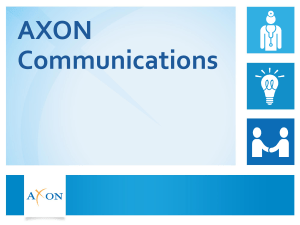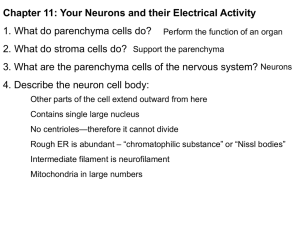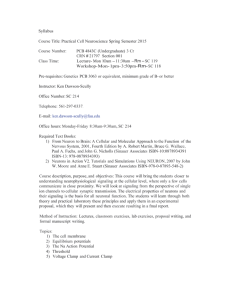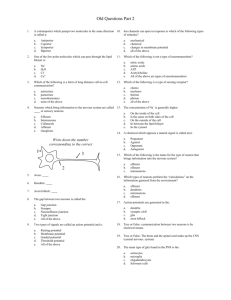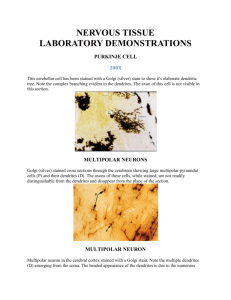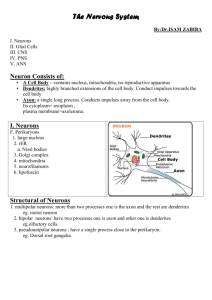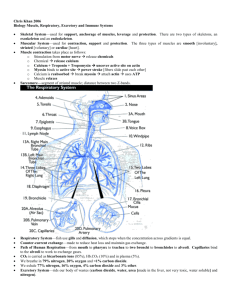Nervous system This tissue or system is able to generate and
advertisement
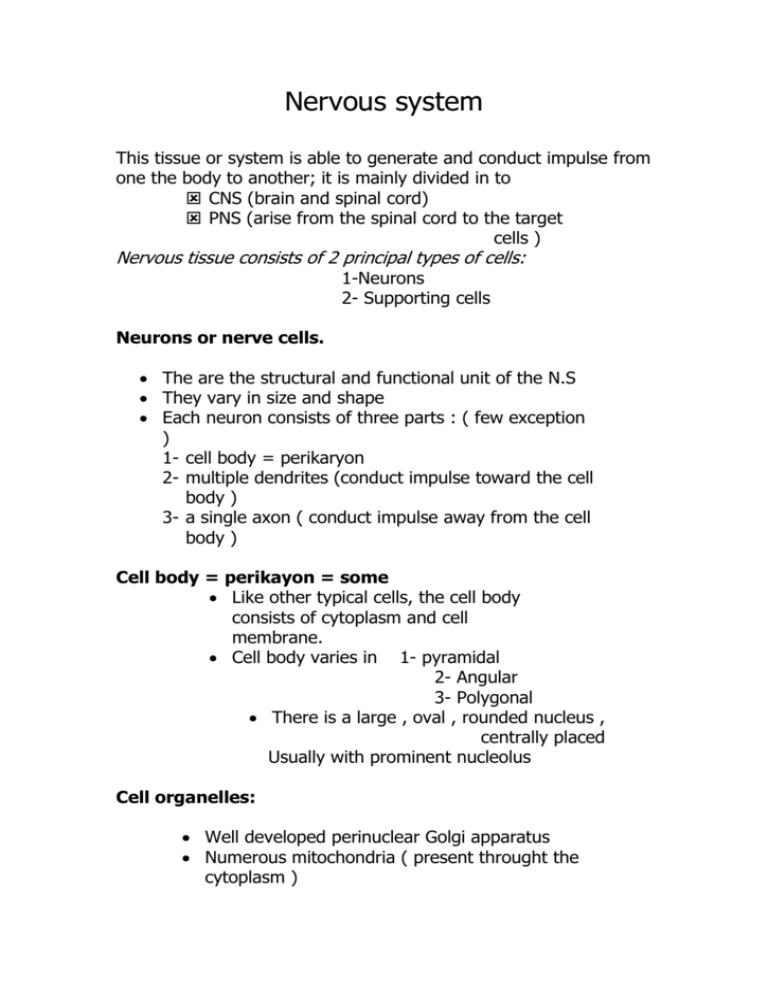
Nervous system This tissue or system is able to generate and conduct impulse from one the body to another; it is mainly divided in to CNS (brain and spinal cord) PNS (arise from the spinal cord to the target cells ) Nervous tissue consists of 2 principal types of cells: 1-Neurons 2- Supporting cells Neurons or nerve cells. The are the structural and functional unit of the N.S They vary in size and shape Each neuron consists of three parts : ( few exception ) 1- cell body = perikaryon 2- multiple dendrites (conduct impulse toward the cell body ) 3- a single axon ( conduct impulse away from the cell body ) Cell body = perikayon = some Like other typical cells, the cell body consists of cytoplasm and cell membrane. Cell body varies in 1- pyramidal 2- Angular 3- Polygonal There is a large , oval , rounded nucleus , centrally placed Usually with prominent nucleolus Cell organelles: Well developed perinuclear Golgi apparatus Numerous mitochondria ( present throught the cytoplasm ) Centrioles ( although nerve are not capable of dividing themselves ) Neurofibrils staining by argyrophilic stain by EM = nerofibrils arrange in bundles of smaller neurofilaments or microfilament (ionm) Neurons show distinctive feature = they are stain by basophilic dyes. This due to the presence of nissl substance (granules ) These granules or bodies are composed of rER exist more in large neurons. These bodies present in the cell body and extend to the dendrites there are few lysosome Inclusions include: Lipofusion pigment (golden brown pigment) with age fat Droplets Melanin in some neurons (substantia negra) Glycogen – present only in the embryonic neurons Axon hillock It a conical portion of the cell body and cytoplasm at the site of origin of axon. It is devoid of nissl granules. The axon usually longer than the dendrite and single. The axon has uniform diameter throughout it is length. The axon can not synthesis it is own protein Protein transport to the axon through the axoplasmic transport process involving microtubules. NB: Drugs which bind to the microtubules affect this process. at: www.occc.edu/.../dennis-tutorial/nervous.html Dendrites: Terminate near the cell body. Irregular in thickness and may posses spines All the organelles extended to them and Rer. The neurons classified according to the number of processes originating from the cell body. Unipolar, bipolar and multipolar cells. Unipolar (mostly refered ps are mainly present in embryonic life, it has one process. In adult present in the me encephalic nucleus of trigeminal (v)5th + sensory ganglion . Special type of unipolar called pseudounipolar occurs in sensory ganglia of cranial nerve (one process divides near cell body in to two procress. Bipolar cell = having tow process one axon and one dendrite present in : - Olfactory mucosa (epithelium) - Retina - Spinal ganglia of the inner ear (chochlea) - Vestibular ganglia of 8th cranial nerve. Multipolar cells = most common Have a single axon and multiple dendrite It posses different shapes Stellate shape A.H.C Sympathetic ganglia Pyramidal or conical = cerebral cortex Purkinje or pyriform flask shaped purkinji cell of cerebral cortex. at: www.med.mun.ca/anatomyts/nerve/neuron.htm Nerve sheaths: Each axon and few dendrites associated with certain cells provide a sheath to it (them). These are schwas cells (known also as neurilema) Shwan cells: Provide the sheath to the axon present outside CNC. Axons lying within the CNS are provided with similar sheaths produce by neuroglia cells called oligodendrocytes. Both cells are responsible for myelination To understand the myelin sheath, we have to know it is formation. An axon lying near the cytoplasm of shwan cell invaginates the cytoplasm of Shwan The axon becomes suspended by a fold of the cell membrane of shwan cell called (mesaxon). In sometime the mesaxon becomes greatly elongated and comes to be spirally wind around the axon thus the axon surrounded by several layers of cell membrane. Lipids (phospholipids and cholesterol) deposit between adjacent layers of the membrane forming myelin. The outermost revolution contains most of the cytoplasm including the nucleus No cytoplasm spaces present in between the inner revolution. Fused cytoplasmic surfaces of the plasmalema appear as a major dense line (3nm wide) These dense lines are interrupted at staggered intervals by narrow channel of cytoplasm connecting the innermost with the outermost revolution of the schwan cell. These channels are called Schmidt – Ianterman clefts. Function of schwan cells: 1. 2. 3. 4. Insulate axon from one another They influence conduction velocity They have major role in nerve regulation Physical support An axon is related to large number of schwan cells over it is length Each Schwan cell provides the myelin sheath a short segment of the axon The junction of tow such segments There is a short gap in the myelin sheath, this gaps are called nodes of ranvier The lipoprotein of myelin serve to insulate axon and are responsible for higher conduction velocities of myelin Ted axon compared with unmyelinated axon The impulse is forced to jump from node; this phenomenon is celled saltatory conduction. This phenomenon provides a faster conduction velocity than those of unmyelinated axon where the impulse (depolarizing ionic current) must propagate along the entire length of the axon. Clinical note: Demyelinating disease affects the conductivity along the peripheral nerve and can be measured Myeline sheath and swan cell sheath are absent (bare area) at the origin of the axon from the axon hillock. This bare area is called initial segment of the axon. From this area action potential is generated e.g of myelinated axon = alphamotor neurons (innervate skeletal muscle) some dendrites of somatic afferent neurons. Each nerve fiber (axon) myelinated or nonmyelinated is covered by endoneurium (innermost C.T sheath) surrounding individual axons Endonrurium holds adjoining fibers (reticular) together and facilitate their aggregation to form bundles or fascicule. Each bundles of nerve fibers or axon surrounded by thicker layer of C.T called perineurium. The inner layer of perineurim is lined by sheet of flat epithelial cells called perineuril epithelial The nerve trunk (consist of multiple fascicular) is surrounded by outermost C.T called epineurium. It is composed of irregularly collagen us and elastic fibers and fibroblasts. Epinerium is continues with the durra matter of the spinal cord. at: www.med.mun.ca/anatomyts/nerve/neuron.htm Histology appearance: Haemotoxylene and eosin stain (H&E) Cross section of fibrous stained with H&E theaxon appear as dots red surrounded by translucent halo (represented the leached out myelin – during preparation lipoprotein dissolve away) Long section of nerve fiber stained with H&E axon are visible as pale, esonephilic , linear structures The nuclei of schwan cells and some fibroblast appears basophilic nuclei .their long axon oriented with the long axon of the nerve Osmium tetroxide The myelin sheath it appears black due to the deposition of reduced osmium The synapse It is the site of junction between two neurons Types: 1- Axodendritic = an axon terminal establishes contact with dendrite – the most type 2- Axo-somatic = an axon terminal establishes contact with nerve cell body 3- Axo-axonal = synapse occur between two axon 4- Synapse between two dendrites 5- Axon terminate in the muscle cell (neuromuscular junction ) 6- Axon terminate in secretory epithelium Synaptic transmission (electrical synapse) occur either by: Conduction of nerve impulse from one cell to another (through depolarization) (1) Bidirectional (2)In C.N.C Or transmitted by chemical transmission i.e releasing of neurotransmitter from the axon to the synaptic site (1) Unidirectional (2) In PNS + CNS (3) Posses structural and functional asymmetry Classical Synapse: The axon terminate in a single bulb like end called baton Because the nerve impulse always transmitted in one direction there are two elements forming the synapse A. Axon button also called presynaptic neuron or synaptic bag B. The dendrite receive the button is called postsynaptic process In between the prensynaptic membrane (from axon) and the post synaptic membrane (from axon) and the post synaptic membrane (from the dendrite) is a synaptic cleft (25 nm) N.B: Electrical synapse two membrane separated by gap junction and no synaptic vesicles. Within the presynaptic vesicles, they are numerous, spherical in shape, membrane bound vesicles containing neurotransmitter. They release their contents by in ot the synaptic cleft. There are cytoplasmic condensations on the presynaptic and post synaptic membrane facing the synaptic cleft. The chemical transmission synapses having the synaptic vesicles in the presynaptic button allow nerve impulse to be transmits in one direction. e.g of chemical synapses = neuromuscular junction . Here the neurotransmitter is acetylcholine. Epinephrine, nor epinephrine and other are e.g of the neurotransmitter Dopamine, GABA, glycine, serotonine, endorphin, enkephalin. Synaptic vesicles also present where there is synaptic transmission takes place. Multiple sclerosis (MS) affect myelin 1-5times >female ages 43-45 demylination in CNS. Neuroglia may be divided into: Macroglia = large glial cells astrocytes Oligodendrocytes Microglia = small glial cells Astrocytes 1- Fibrous astrocytes astrocytes Site White matter Cytoplasmic Several, long, thin Process asymmetrical Nucleus EM oval, euchromatic rich in glial filament (Intermediate microfilaments) 2- Protoplasmic Grey matter shorter, thicker symmetrical same same End The processes frequently end in expansions (foot process) in relation to blood vessels just beneath the pia matter (glia limitaus) N.B They may a phagocytosis the cell debris and form scars. Oligodendrocytes They are the myelinating cell of the CNS They have fewer processes, short, less branched, rounded or pear shaped cell body. Hetrochromatic nucleus. Having abundant microtubules. Present grey & white matter. One cell can produce myelin to several axons (unlike Schwan). Microglia They have unknown origin (could be mesodermal) all neurglia are ectodermal from neuroepithelium (Neural plate) grey & white matter. They may act as macrophages & become swallow during inflammation of CNS. They run spindle shaped cell. They have deeply staining, elongated nuclei and few short, irregular cytoplasmic processes best identify with silver stain. They are frequently seen near the capillaries. Function 1- Provide mechanical support. 2- They serve an insulator. 3- They maintain suitable metabolic environment to the neuron. 4- They responsible for damage of affected area in brain by processes called glivis (also phagocytosis). 5- Oligodendrocyte provides myeline sheaths. 6- Ependymal cells responsible for exchange of material between brain and csf. They produce csf because present in choroids plexus. Other types of neuroglia – ependymal cell (simple columnar Cells…..? Neuroglial tumor: 50% of intracranial tumor: Oligodendroglioma Malignant osteocystomas Tumors of neurons…..? Ganglia: They are aggregations of cell bodies of neurons outside the brain and spinal cord. They covered by C.T capsule that is continues with epineurium & perineurium of nerve fibers entering or converging from ganglion. There are two types of ganglia SENSORY GANGLIA Site Shape Organization Type Nucleus Dorsal root ganglia of spinal nerve (dorsal nerve root ganglia). Cranial nerve ganglia present in 5, 7, 8, 9 and 10 cranial nerve. Their axon from the afferent fiber of peripheral neuron. They have large cell bodies. AUTONOMIC GANGLIA Cell bodies of the postganglionic neurons. Their afferent nerve supplies the smooth muscle & gland and refers as postganglionic nerve fiber. Neurons have smaller cell bodies (30 uM). About 120 uM I diameter (few with 20 uM) Neuron arrange in groups mainly concentrated near the capsule. Cranial nerve ganglia are pseudounipolar except 8 having bibolar. Other are unipolar, Actually pseudounipolr. Neurons scattered all over the ganglia Multipolar neurons (irregular cell bodies). Central nucleus within rounded shape cell body. Eccentric nucleus within irregular cell body. SENSORY GANGLIA Capsular cell Each cell body is surrounded by a layer of flattened capsular cells or satellite cells. Connective Tissue External to satellite cell is basal lamina and external to that is a C.T. capsule composed of collagen fibers and fibroblast (called capsular cell). Blood supply Nerve ending AUTONOMIC GANGLIA Capsular sheet of satellite cells not well defined. Same but well defined. Poor blood supply. Rich in blood supply. Myelinated. Concentric in the center of the ganglia (numerous). Receive dendrites from free nerve ending (receptor to pain, pressure, temperature and from encapsulated receptor (for touch & pressure) Non myelinated (not numerous). Receive preganglionic neurons of (CNS).



